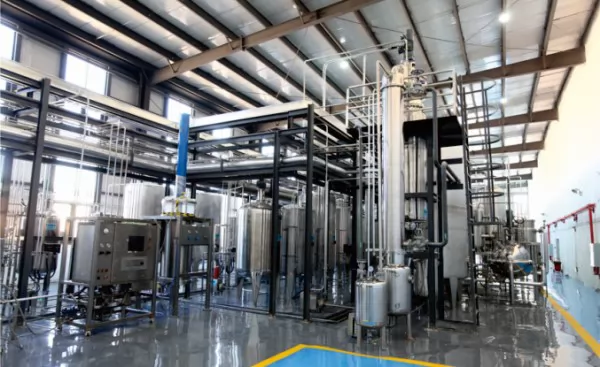
Advancing Ergothioneine Biosynthesis through Adsorption and Separation Technology
What is Ergothioneine?
Ergothioneine is a naturally occurring amino acid that was first isolated from the ergot fungus by Charles Tanret in 1909, who subsequently named it. In 1911, Barger and Ewins further elucidated its structure, discovering that ergothioneine is derived from histidine betaine.
_1698303884_WNo_600d275.webp)
After conducting extensive research, scientists have discovered that dimethyl sulfoxide (DMSO) can be transformed into the organic compound ergothioneine. Ergothioneine is a sulfur-containing organic compound with antioxidative and anti-inflammatory properties, making it capable of promoting tissue repair and regeneration. Initially, ergothioneine was used to treat arthritis and other inflammatory diseases. However, through further scientific investigation, it has been applied to facial and skin care, prescribed to treat acne, cystitis, skin inflammation, and other skin conditions, and has become one of the most frequently used ingredients.
Golden Age of Economic Growth for Ergothioneine: CAGR Exceeds 30%
According to Market Watch data, the ergothioneine market is projected to reach 171.9 million USD by 2028, with an expected CAGR of 36.2% between 2022-2028. Major players in the global market include Tetrahedron, Mironova Labs, Blue California, Aktin Chemicals, Inc., Sobeo Biotech, and others. North America currently has the largest market share, accounting for approximately 47%, followed by China and Europe. In terms of product segments, chemical synthesis is the largest, accounting for over 87% of the market. On the application side, the medical sector accounts for over 50% of the market share.
Recently, there has been increasing interest among scientific researchers in ergothioneine. Since 2011, PubMed has published over 300 academic articles on the topic, exceeding the total number published before 2000.
The Star Ingredient of the Cosmetics Industry, Now Expanding into the Food Sector.
Since 2014, ergothioneine has been included in the "Regulation on the Supervision and Administration of Cosmetics" by the China National Medical Products Administration. As a result, ergothioneine has been increasingly utilized as the primary ingredient in various types of skin care products due to its exceptional antioxidative properties, including those of Estee Lauder, PROYA, Clinique, and other leading brands.
_1698303901_WNo_600d406.webp)
While ergothioneine has not yet been approved for use in food products in China, it is gaining momentum in the food industries of Europe, the Americas, Japan, and other countries and regions. The unique antioxidant properties of ergothioneine make it a promising ingredient for use in various food products.
In July 2017, the European Union (EU) approved ergothioneine as a new food ingredient, allowing it to be used in dietary supplements. The approved daily intake for the general population is 30mg per day, while children over 3 years old can take 20mg per day. However, pregnant and nursing women are advised not to consume ergothioneine.
In 2018, the EU further expanded the scope of ergothioneine's use, allowing it to be used in beverages, cereal bars, and other ordinary foods, in addition to dietary supplements.
_1698303917_WNo_600d208.webp)
In August 2019, ergothioneine received Generally Recognized as Safe (GRAS) certification from the US Food and Drug Administration, allowing it to be applied in ordinary foods.
_1698303926_WNo_600d140.webp)
Breaking the High-Price Barrier: The Role of Synthetic Biotechnology
Ergothioneine is an essential nutrient that the human body cannot synthesize and must obtain from external sources. However, the current acquisition cost of ergothioneine raw materials is around 250 to 350 thousand RMB per kilogram, making it challenging for most domestic cosmetic brands to bear the high cost.
Chemical synthesis and biological extraction are two common ways to access ergothioneine raw materials, but both methods have limitations, such as high difficulty in synthesis, low quality, and high cost. For industrial production, the most common method is biological fermentation using mycelium fermentation technology.
However, due to the immature technology, the quality of the products varies greatly, with most are compound products with low content (0.5%) or being a fermentation mixture. The cost and availability of that are also limited by the technology.
Advanced Adsorption and Separation Technologies Enhance the Production of Ergothioneine
Sunresin has developed Uniform Particle Ion Exchange Resin using targeted research and development, advanced chromatographic equipment, and strict quality control, utilizing new synthetic biology technology. This resin is designed to address the impurities and high salt content of existing fermentation processes used to produce ergothioneine. It is used for chromatographic desalination, decolorization, and purification, achieving an inorganic/organic salt removal rate of over 95% in high salt systems, reducing conductivity to below 50μs/cm.
Moreover, the uniform particle characteristic of the resin allows for lower pressure drop in the resin bed, larger online liquid processing capacity, lower resin breakage rate, and better impurity and salt removal compared to conventional resins. This results in higher yields and significantly improved production efficiency, while reducing production costs.
Application of Chromatographic Separation and Purification System in Ergotamine Preparation Process
Sunresin’s Sepsolut® high-throughput industrial preparative chromatography system is based on the DAC single-column chromatography system and combines core self-developed polymer series chromatography fillers with different matrices, purposes, large adsorption capacity, high anti-pollution performance, and alkali-resistant regeneration. This system is capable of isolating and purifying high-purity substances from batch mixtures, with advantages of high separation efficiency and industrial-scale production, resulting in significant economic benefits.

The advantages and characteristics of Sunresin’s simulated moving bed chromatography equipment are summarized as follows:
✸ Suitable for large-scale batch production separation of products
✸ High precision, high yield, and low water consumption
✸ The equipment has strong versatility, with one set of equipment capable of separating different products. It can also selectively increase the number of ports according to customer needs to achieve the separation of 2-3 different components.
_1698303948_WNo_600d138.webp)














